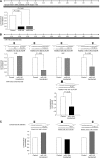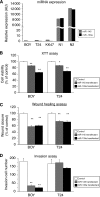miR-145 and miR-133a function as tumour suppressors and directly regulate FSCN1 expression in bladder cancer
- PMID: 20160723
- PMCID: PMC2833258
- DOI: 10.1038/sj.bjc.6605570
miR-145 and miR-133a function as tumour suppressors and directly regulate FSCN1 expression in bladder cancer
Abstract
Background: We have recently identified down-regulated microRNAs including miR-145 and miR-133a in bladder cancer (BC). The aim of this study is to determine the genes targeted by miR-145, which is the most down-regulated microRNA in BC.
Methods: We focused on fascin homologue 1 (FSCN1) from the gene expression profile in miR-145 transfectant. The luciferase assay was used to confirm the actual binding sites of FSCN1 mRNA. Cell viability was evaluated by cell growth, wound-healing, and matrigel invasion assays. BC specimens were subjected to immunohistochemistry of FSCN1 and in situ hybridisation of miR-145.
Results: The miR-133a as well as miR-145 had the target sequence of FSCN1 mRNA by the database search, and both microRNAs repressed the mRNA and protein expression of FSCN1. The luciferase assay revealed that miR-145 and miR-133a were directly bound to FSCN1 mRNA. Cell viability was significantly inhibited in miR-145, miR-133a, and si-FSCN1 transfectants. In situ hybridisation revealed that miR-145 expression was markedly repressed in the tumour lesion in which FSCN1 was strongly stained. The immunohistochemical score of FSCN1 in invasive BC (n=46) was significantly higher than in non-invasive BC (n=20) (P=0.0055).
Conclusion: Tumour suppressive miR-145 and miR-133a directly control oncogenic FSCN1 in BC.
Figures





Similar articles
-
The evolving understanding of microRNA in bladder cancer.Urol Oncol. 2014 Jan;32(1):41.e31-40. doi: 10.1016/j.urolonc.2013.04.014. Epub 2013 Aug 2. Urol Oncol. 2014. PMID: 23911686 Free PMC article. Review.
-
miR-145, miR-133a and miR-133b: Tumor-suppressive miRNAs target FSCN1 in esophageal squamous cell carcinoma.Int J Cancer. 2010 Dec 15;127(12):2804-14. doi: 10.1002/ijc.25284. Int J Cancer. 2010. PMID: 21351259
-
Functional role of LASP1 in cell viability and its regulation by microRNAs in bladder cancer.Urol Oncol. 2012 Jul-Aug;30(4):434-43. doi: 10.1016/j.urolonc.2010.05.008. Epub 2010 Sep 16. Urol Oncol. 2012. PMID: 20843712
-
MiR-133a induces apoptosis through direct regulation of GSTP1 in bladder cancer cell lines.Urol Oncol. 2013 Jan;31(1):115-23. doi: 10.1016/j.urolonc.2010.09.017. Epub 2011 Mar 10. Urol Oncol. 2013. PMID: 21396852
-
The role and regulatory mechanism of FSCN1 in breast tumorigenesis and progression.Yi Chuan. 2023 Feb 20;45(2):115-127. doi: 10.16288/j.yczz.22-346. Yi Chuan. 2023. PMID: 36927659 Review.
Cited by
-
MicroRNAs in non-small cell lung cancer and idiopathic pulmonary fibrosis.J Hum Genet. 2017 Jan;62(1):57-65. doi: 10.1038/jhg.2016.98. Epub 2016 Aug 4. J Hum Genet. 2017. PMID: 27488441 Review.
-
The evolving understanding of microRNA in bladder cancer.Urol Oncol. 2014 Jan;32(1):41.e31-40. doi: 10.1016/j.urolonc.2013.04.014. Epub 2013 Aug 2. Urol Oncol. 2014. PMID: 23911686 Free PMC article. Review.
-
[Modern networks : Topics in the working group "Bladder cancer research" of the GeSRU Academics].Urologe A. 2017 Feb;56(2):202-207. doi: 10.1007/s00120-016-0217-z. Urologe A. 2017. PMID: 27604705 Review. German.
-
Lidocaine inhibits growth, migration and invasion of gastric carcinoma cells by up-regulation of miR-145.BMC Cancer. 2019 Mar 15;19(1):233. doi: 10.1186/s12885-019-5431-9. BMC Cancer. 2019. Retraction in: BMC Cancer. 2024 Feb 21;24(1):241. doi: 10.1186/s12885-024-12011-4. PMID: 30876463 Free PMC article. Retracted.
-
Urinary microRNAs as potential biomarkers for differentiating the "atypical urothelial cells" category of the Paris system for reporting urine cytology.Int J Clin Exp Pathol. 2017 Aug 1;10(8):8303-8313. eCollection 2017. Int J Clin Exp Pathol. 2017. PMID: 31966681 Free PMC article.
References
-
- Childs G, Fazzari M, Kung G, Kawachi N, Brandwein-Gensler M, McLemore M, Chen Q, Burk RD, Smith RV, Prystowsky MB, Belbin TJ, Schlecht NF (2009) Low-level expression of microRNAs let-7d and miR-205 are prognostic markers of head and neck squamous cell carcinoma. Am J Pathol 174: 736–745 - PMC - PubMed
-
- Darnel AD, Behmoaram E, Vollmer RT, Corcos J, Bijian K, Sircar K, Su J, Jiao J, Alaoui-Jamali MA, Bismar TA (2009) Fascin regulates prostate cancer cell invasion and is associated with metastasis and biochemical failure in prostate cancer. Clin Cancer Res 15: 1376–1383 - PubMed
-
- Friedman JM, Liang G, Liu CC, Wolff EM, Tsai YC, Ye W, Zhou X, Jones PA (2009) The putative tumor suppressor microRNA-101 modulates the cancer epigenome by repressing the polycomb group protein EZH2. Cancer Res 69: 2623–2629 - PubMed
Publication types
MeSH terms
Substances
LinkOut - more resources
Full Text Sources
Other Literature Sources
Medical
Miscellaneous

